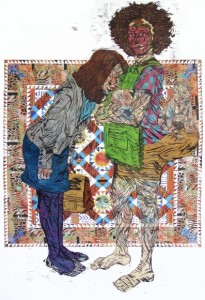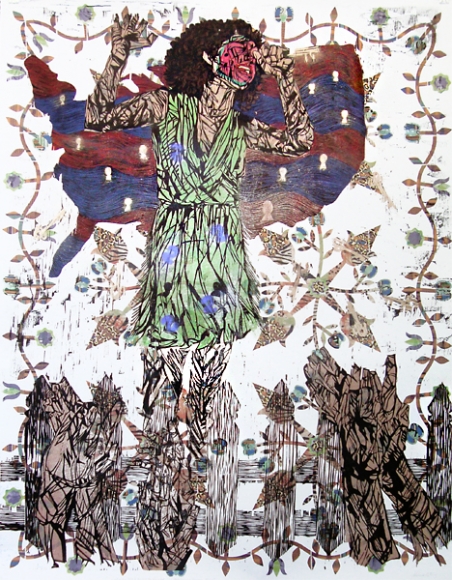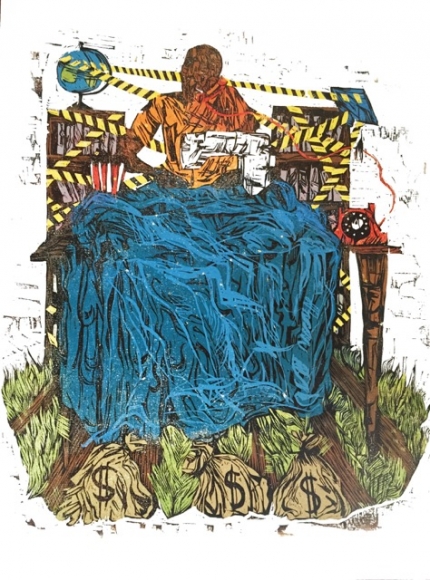
Katrina Andry: In my work I deal with with the historical aspect of stereotypes perpetuated against black people.
About:
A native of New Orleans, LA, Katrina Andry received an M.F.A in printmaking at Louisiana State University, Baton Rouge, in 2010. She currently lives and works in New Orleans and continues to make some of her bigger works at the Xavier University.
Disappear, 2014.
Andry’s work explores the negative effects of stereotypes on the lives of minorities and how these stereotypes give rise to biased laws and ideologies in the Western World. Her large-scale prints—some as big as five feet—confront the viewer with these derogatory cultural clichés. The prints feature figures in watermelon/black face. They represent those who are targeted by racist characterizations. However, Andry specifically uses non-minority figures in this role to illustrate the fact that stereotypes are unjustly perpetuated. Stereotypes are neither based in truth nor innate characteristics of a specific person, instead they are ideas forced onto a group of people as a whole. Portraying entire populations in a negative light, stereotypes confer on the perpetuator an impression of superiority and a greater sense of normalcy.
Stop Them. Arrest Them. Charge Them. We Dont Want Them to Vote, 2012.
Andry was listed in the September, 2012 Art in Print magazine as one of the top 50 printmakers. Her work was also featured on the popular Beautiful Decay blog. She has recently shown at Staple Goods Gallery, New Orleans, in a group show, Shape of Place, curated by each of the collective’s members. She has also been an artist-in-residence at Anchor Graphics in Chicago and Kala Art Institute in Berkeley, CA.
(Courtesy: JONATHAN FERRARA GALLERY, 400A JULIA STREET, NEW ORLEANS.)
STATEMENT
Stereotypes are well ingrained into our Western culture, and are used almost instinctively in order to deal with our differences. Though, the byproduct of stereotypes is that they also create differences between people, and stereotyping establishes an arbitrary set of societal norms/rules that benefit the majority while it disenfranchises other groups of people. An example of this would be having a mullet. Having a mullet may be socially acceptable in your subculture, but is widely viewed as a stamp of ignorance and a red neck mentality on part of the person sporting the mullet. Therefore, not having a mullet makes you smart and having a mullet makes you ignorant, though hairstyle [scientifically] has nothing to do with levels of cognizance. My work challenges ideas about black people (Other) that once ago had scientific research qualifying them, and how these ideas or stereotypes have become a part of how we see each other whether consciously or unconsciously.
The Keys to the Gated Community and White Acceptance, 2010.
Stereotypes are reiterated in our culture on a daily basis by the Media in all forms, and it’s hard to deny that the source of your information has a lot to do with how you perceive the world around you. The media plays a heavy role in the propagation, perpetuation and continuation of stereotypes in our society.
Corporations Pay in Peanuts and Sheriffs Make Out Like Fat Cats, 2012.
In my work I deal with with the historical aspect of stereotypes perpetuated against black people: how did they come to be, what are they based on, and in what way is it harmful to black people in America? I put white males in black face acting out what people generally perceive to be stereotypes of black culture. I use white males because they are seen as figures of authority. By putting white males in black face I let the audience know that the piece is about perception and not reality, and that is how the West perceives the Other.




